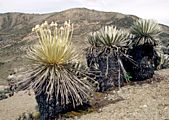Avoidance of freezing
Once exposed to freezing temperatures, many plants are able to prevent the formation of ice. Freezing avoidance in exposed tissues can be achieved by
- accumulation of anti-freeze solutes, which depress the freezing point of the cell sap. This is a very inefficient mechanism, because it needs 1 mole of solutes (e.g. sugars) for a 1.8 K depression of the freezing point, with the osmotic pressure increased by 22 bar per mol of solute (which means more than doubling common osmotic pressures). *
- preventing freezing by "supercooling". By not fully understood mechanisms, some plants can delay ice formation by inhibiting nucleation. Liquid water is maintained in a meta-stable state. Once nucleated, freezing occurs immediately (commonly around -12° C) and kills the tissue. Thus, supercooling is a fatal strategy in areas in which temperatures may drop below -12° C but is adopted by some high Andean giant rosettes.
Note: no higher plant is known to survive natural protoplast freezing. Ice formation, if it does occur, must be outside the protoplast (see below).
* Be sure to distinguish °C (degree Celsius) from K (the Kelvin), the measure of absolute temperatures and of temperature differences at any temperature. The use of K for differences helps to avoid confusion with temperatures and conforms with rules in physics. Because the Kelvin scale is not a relative degree scale, it is wrong to write and say "degree Kelvin".


